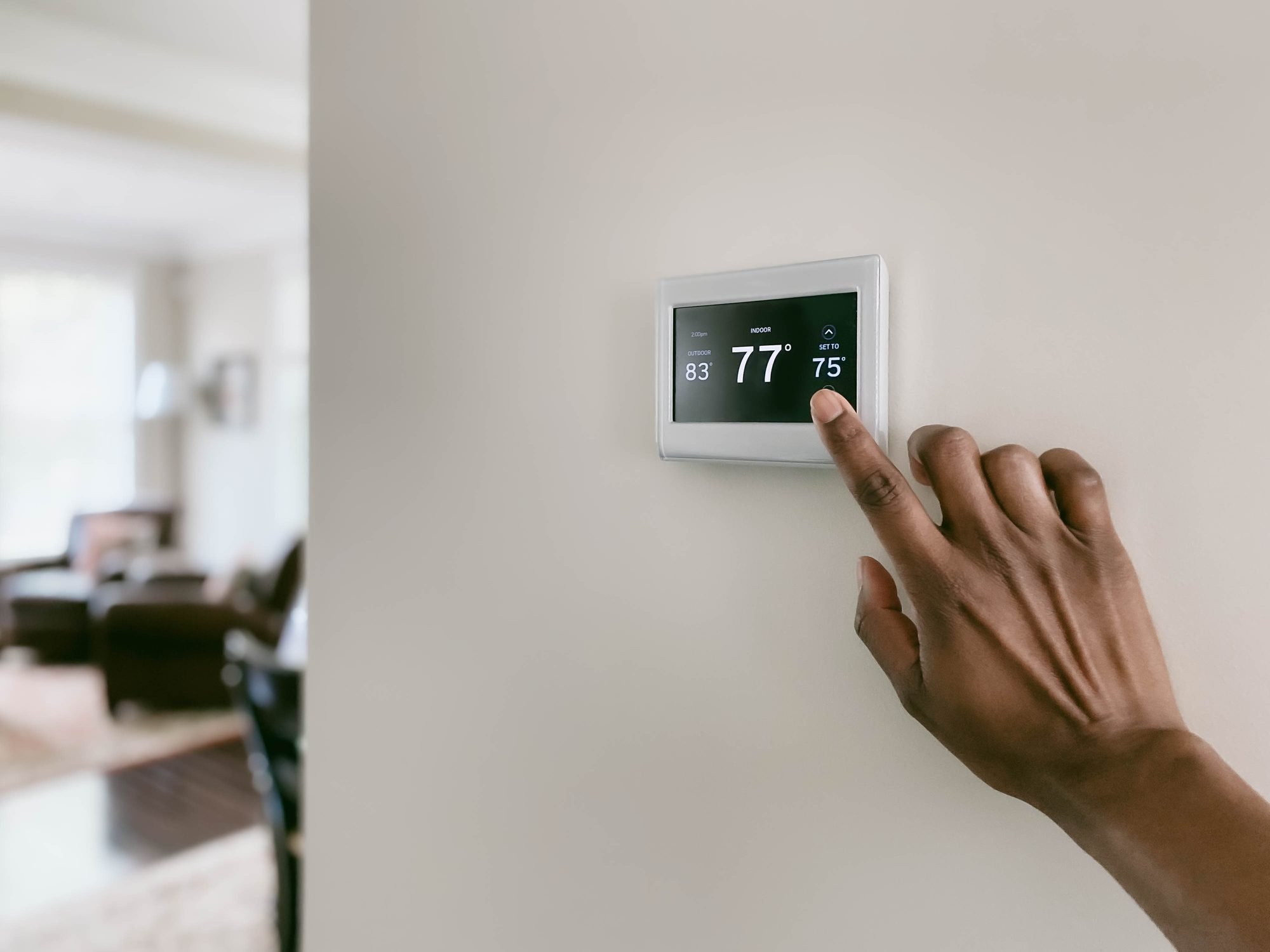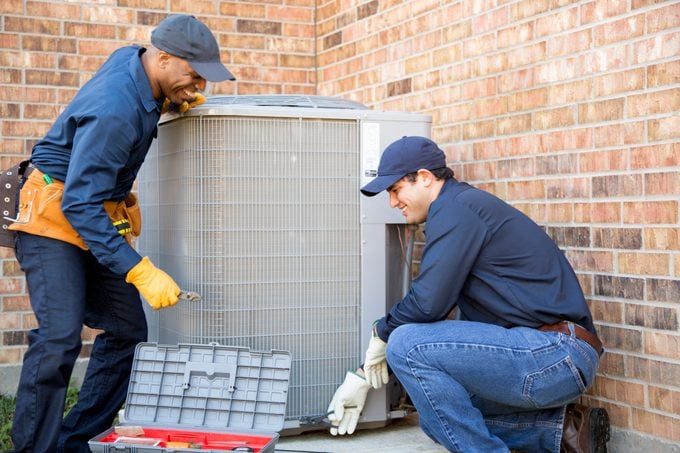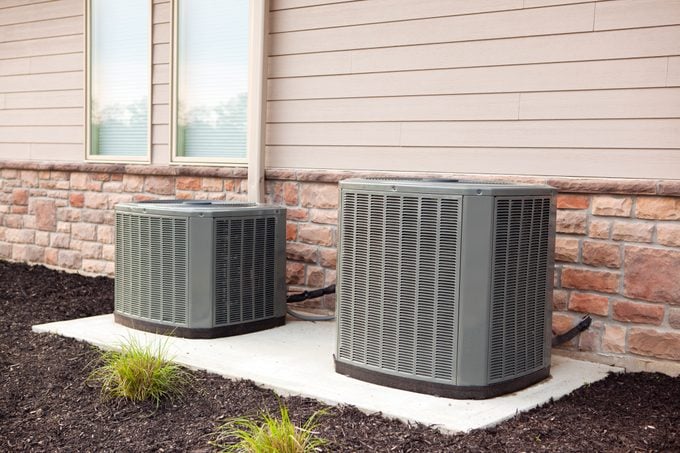Wondering how central air installation works? We'll explain key phases, what's involved at each step and best practices for working with a pro.

Central Air Installation Guide

Almost all homes built in the U.S. have air conditioning of some type. Whether you’re considering central air for a new build, replacing an existing unit or retrofitting an existing home for the first time, here is some background and insight to help you understand the process.
On This Page
Definitions
Before we start, let’s go over a few terms you need to know.
Central air conditioner
A central air conditioner cools air in one location, then uses the air handling capabilities of the furnace to distribute that cool air throughout the home. This distinguishes it from window or wall air conditioners or mini-split systems, all of which cool relatively small areas and rely on multiple units to cool the whole house.
In the U.S., most single-family homes with central air have a split system. This means the unit is split into two key components, an evaporator coil inside the home and a compressor outside.
Heat pumps are another form of central air conditioning. But for this article, we’re focusing on projects that connect central air to a furnace. If you are considering a heat pump, note the pricing and steps involved will be different.
Sizing
When discussing air conditioners, you’ll often hear “size” mentioned. This refers to cooling power of the air conditioning unit, not the physical dimensions.
Heating, ventilation and air conditioning (HVAC) professionals use a measure called a British thermal unit (Btu), the energy required to lower the temperature of a pound of water by one degree Fahrenheit. In their vernacular, 12,000 Btu is described as a ton. So a 2.5 ton air conditioner equals 30,000 Btu.
Efficiency
Efficiency is measured as the seasonal energy efficiency ratio (SEER). Higher SEER units are more efficient, usually by employing a two-stage compressor and variable-speed blower. In both instances, this means the air conditioner will consume less energy when the temperature is lower.

Central Air Installation: Can I DIY?
We’re big fans of the DIY ethos here at Family Handyman. But we also recognize that some projects should only be tackled by professionals or DIYers with extensive previous experience.
For the vast majority of homeowners, central air conditioning installation involves too many specialized skills and too high a risk of failure to attempt without professional help. This is due to the skills required, the bureaucratic wrangling of permits, licensing requirements and the potential voiding of warranties if you install the components incorrectly.
If you have your heart set on DIY, you can do most of the work yourself. But handling the refrigerant will require a licensed pro. And in some locations, only a licensed electrician can connect the electrical to the service panel.
Working With Professional HVAC Installers
When talking to contractors, ask questions to learn how they’ll approach the project. And pay attention to the questions they’re asking you! An installer should ask clarifying questions so your choices and preferences will be reflected in their estimate and the finished product.
Planning
Installing central air conditioning is a big project, and doing it right means investing some time in planning. Ask your contractor to review their process, and verify that they’ll be handling any required permits or other essential paperwork.
Talk to your contractor about how much you prioritize energy efficiency versus upfront cost. This is also a great time to go over the location of the condenser unit and what kind of thermostat you’d like.
Sizing
Your contractor will help identify the proper size central air conditioner for your home. This is essential because a unit that’s too small will run almost constantly, while a unit that’s too large will cool the house too fast and shut down before completing a full cycle.
In the latter scenario, the rapid on/off is rough on the system. It can cause the evaporator coil to freeze over, and a frozen coil won’t allow air to circulate. That means an oversized air conditioner can actually be less effective at cooling than an undersized unit.
To determine the right unit for your home, your HVAC installer will perform a calculation called a “Manual-J.” This will cover all the factors we’ve discussed and more, giving the most accurate sizing possible.
However, we know that many homeowners want a rough idea of what size they need in advance. So here’s a “back-of-the napkin” estimate of central air conditioner size: Multiply the square footage of your home’s conditioned space by 25 to give you the Btu required, then divide by 12,000 to get the tonnage.
Remember, though, this is only a rough estimate, and there are many variables. If the first floor of your home has 12-foot-tall ceilings, the air conditioner will have more air to cool. And if you have lots of southern-exposure windows, they’ll be more sun and natural heat to deal with.
Estimates
Once you’ve gone over the basic plan and discussed model options, the contractor should give you an estimate. As always, get estimates in writing from multiple vendors. The only exception would be if you’re putting air conditioning into a new build, since your builder likely will handle it.
Whether dealing with a builder or independent HVAC contractor, don’t be afraid to ask clarifying questions or request expense breakouts. Even if the contractor can’t itemize everything, they should be willing to communicate enough to make you more comfortable with the process.

The Central Air Installation Process
The installation should take about a day to complete. Below is a summary of the main steps.
- Duct work installation or modification
- For homes with existing furnaces or air conditioning, any duct work should be minimal, usually no more than an additional return line.
- If you do need to have ducts installed, work with your contractor to find ways to hide them in closets or soffits to avoid extensive drywall repairs.
- For new builds, duct work should be completed before the drywall is installed.
- Interior unit
- The evaporator coil fits inside the furnace plenum.
- The plenum is the section of the furnace on either side of the air handler, where air is brought in and sent back out into the house.
- The evaporator coil will go into the supply plenum, which can be thought of as the “outflow” of the furnace.
- The evaporator coil fits inside the furnace plenum.
- Exterior unit
- The placement of the exterior unit is determined by a few factors, including:
- The length of run to the interior unit and electrical service panel;
- How level the ground is;
- How close the noisy exterior unit will be to windows or doors;
- Code-required distances from gas or water meters (refer to your local building department for specifics).
- The placement of the exterior unit is determined by a few factors, including:
- Connect the line set
- The two halves of a split system are connected by a pair of copper pipes, which form the path the refrigerant will cycle through.
- The path of the line set will largely be determined by the most direct route from the evaporator to the condenser.
- If you have any concerns about the route, bring them up to the contractor as early in the process as possible.
- The penetration to the exterior should be sealed to prevent water infiltration.
- Connect the Electrical Supply
- The condenser unit will need an exterior shutoff installed.
- The electrical line will run from the condenser to the shutoff, and from the shutoff to the electrical service panel.
- If your circuit panel is already maxed out, you may need to upgrade it to handle the additional load of the air conditioner.
- If the project was planned properly, any work on the panel should already be included in the project estimate.
- There will also be a low-voltage wire connecting the condensing unit to the furnace so it can be controlled by the thermostat.
- Condensate Drain Line
- All air conditioners generate condensation, much like the sides of a glass of ice water. That condensation needs to be drained.
- Units located in a basement typically run to a floor drain.
- Units located in attics may pipe water outside, or may use a drain pan that allows water to evaporate — the same way refrigerators allow condensation to evaporate.
- Thermostat
- If you’re installing central air conditioning in a new build, you’ll need to choose a thermostat.
- If you’re installing central air conditioning into an existing home, you may need to upgrade the thermostat to one that can control cooling as well.
- This is one step of the process that’s a great place for a little DIY effort.
- Some homeowners purchase a bare-bones thermostat for the install, and then upgrade to a programmable or smart thermostat on their own.
How Much Does Central Air Installation Cost?
As with any large project, prices vary depending on local market and the specifications of the job. A typical split system central air installation using an existing furnace should cost between $3,000 and $5,500 for labor and materials. On average that cost will be split about 60/40, with the majority falling under labor.
It’s possible to purchase the AC system on your own and ask an HVAC pro to install it for you. But keep in mind you’ll likely be paying full retail instead of getting a commercial discount, so the overall cost of the job may not be any less than the contractor’s estimate. You’ll also have to do the sizing on your own, and you’ll bear the responsibility if there are any issues with the equipment.
If you’re replacing an existing central air conditioning system, expect an additional charge to remove and dispose of the old system and refrigerant, probably in the $150 to $200 range. If you’re installing a furnace and air conditioning, the cost of each component will usually be discounted, although the overall price of the job will be higher.
Conclusion
Installing a central air conditioner is a great way to boost the value of your home while maintaining a comfortable environment for you and your loved ones. It’s a complicated installation, but hopefully this overview helps you understand the process.
Don’t hesitate to ask questions of your installer along the way to make sure your central air conditioner installation goes as smoothly as possible!



















